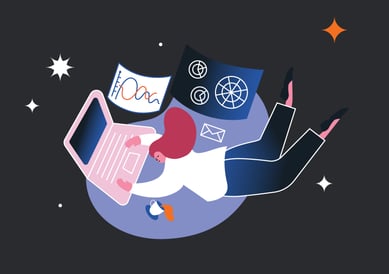

Chin Yin Ong
Head of People

The last few months have forced us to revisit our traditional employee engagement models.
We have questioned if transactional systems still work and whether our digital infrastructures are up to the task of enabling connectivity at this massive scale. HR teams around the world have asked themselves one critical question: what does employee engagement look like when we can no longer meet face-to-face?
And what does this mean for the months to come, as offices partially reopen, but most of us continue to deal with a hybrid workforce?
Our recent event, titled PeopleFirst 2020, put these issues under the magnifying glass. On the occasion of our fourth anniversary, we were delighted to partner with SkillsFuture Singapore and Lifelong Learning Institute to explore the future of talent engagement in 2021.
Chin Yin Ong, Head of HR at Grab, started the event, sharing her experiences and thoughts on the road ahead.
Grab is a Singapore-based multinational ride-hailing company that employs approximately 6,000 people as of 2019.
The company is recognised for its effective HR policies, so the pandemic definitely caused substantial disruption. “We started to build different structures to support and engage our teams better very quickly,” said Chin Yin. The first step was to ramp up IT infrastructure capacity dramatically by up to four times.
“We wanted to make sure that there will be no downtime in connectivity during this whole period. We observed more than 145,000 Zoom meetings over 26 million+ minutes in June 2020 alone. That's about a 5x increase compared to the peak monthly usage in pre-COVID times. We set up and configured about 1000 computers in 10 days so to enable our people in our customer service teams to continue to operate from home,” Chin Yin shared a glimpse into these remarkably agile numbers.
As Grab progressed, they were spending much more time on important (non-transactional) topics such as encouraging “Grabbers” to take care of their wellbeing, and how to enhance engagement once home-based productivity was settled.
This led to some inspiring ideas.
Engaging talent in a meaningful way is more than providing employees with functional Wi-Fi and Zoom access. Grab recognised this early on, and decided to take 5 steps.
This is a difficult issue, something that most of us have faced as we comply with COVID-19-related regulations and the associated uncertainty. “I'm a mother of two kids and the wife of a frontliner, and during the COVID times, I realised that life had changed a lot for me,” Chin Yin said.
“I started to see that I was becoming the most introverted self that I've ever observed. That was until I spoke to more of our teammates on the ground. It was astounding to hear how much harder it’s been for some of them. Family and friends have been directly or indirectly impacted in a physical manner, or financially, or mentally. And the worst part of it is they found it very hard to share their stories at work.”
To address this, Grab adopted Workplace from Facebook that would consolidate all the relevant COVD-19-related content in one place.
“We not only gave information about whether the office is open/closed or whether there are any infections within the organisation, but we also started to build a lot more content around to cope. How do you provide, you know, mental wellbeing support to each other?” mentioned Chin Yin.
One of the challenges of creating talent engagement and wellbeing content is getting people to tune in.
“Not everybody reads the columns even though we send it out rather regularly. So, we asked ourselves, how do different people like to hear the news?” said Chin Yin. That’s when Grab came up with the idea of company radio.
Audio has always been a more effective medium for idea exchange than plain text. The same principle could also aid in talent engagement, where HR engages the workforce through actual conversations.
“G Radio is really a very scrappy radio station that we built very quickly. It broadcasts twice a week at the peak and then once a week after that. There's a platform where grabbers who are separated from each other right now have the ability to share messages of love through a dedication on radio and have some fun. This is a totally internal project done by HR people with no experience in DJ-ing,” Chin Yin elaborated Grab’s success story.
Audio, video, infographics, live streaming, social media, and other non-conventional communication formats can prove to be surprisingly effective at times like these. It tells employees that you aren’t afraid to go out of your way and step outside the box.
Importantly, not all employee groups will react to a crisis in the same way, and some will be more vulnerable to risk and disengagement. For example, EngageRocket’s research found that parents are 2x more likely to be stressed than the average employee; 68% work longer hours to make up for any lost productivity due to child-rearing.
Take inspiration from Grab, which embedded a dedicated space for supporting parents on their talent engagement microsite.
“We built a microsite in 8 days with different sections, so that people who prefer to research on self-help during this period can get all the information they need on one microsite. We have sections around, staying sane, connected, and productive. For people managers, we have a section about managing teams through remote working because sometimes they're not very used to virtual teams,” Chin Yin described the project.
“Also, parents needed an extra helping hand. So we put together a safe learning website for kids. Grabbers uploaded videos of storytelling so anyone could play those videos for our kids. Our marketing team put together colouring kits and activity booklets every week to keep our children occupied,” she added.
In 2021, it will be vital to develop targeted engagement strategies for vulnerable groups, including managers, parents, new employees, and others at risk of stress.
The impact of talent engagement stays with us well beyond the 9-to-5. At a time when our approach to communicating with the external world has gone through a tectonic shift, HR can remind employees of human relationships, empathy, and their personal identities/aspirations beyond work.
That’s why Grab conducts an event called Grabtitude – “ Grabtitude Day makes things light-hearted and fun. Grabbers spend time together doing social things. There was cooking with Michelle, one of our Grabbers, and there was also working out sessions with Anthony, our CEO, and his wife, Chloe. We also had sessions about learning how to draw. We wanted to make sure that our shared experiences and memories can continue to build together,” Chin Yin explained the drivers behind the move.
Another way to encourage self-expression was Grab’s new bot that would match employees for non-work-related interactions.
“We built a bot called Coffee with Carl that would pair Grabbers. People could sign up, get matched, possibly meet a grabber they have never worked with before, and have a Zoom coffee. These cross-country connections really found time before COVID happened,” said Chin Yin.
Purpose has been among the top drivers of engagement during the crisis. It can dissuade people from resigning, it encourages referrals, and the feeling of shared purpose drives up productivity.
“We found that the purpose of the company at Grab has kept many, many people motivated. If you are in an organisation that hasn't had ‘purpose’ very clearly defined, this is a good moment to clarify that well. You should also be able to communicate it over and over again to teams and why they do what they do,” Chin Yin explained.
A simple way to do this is to start from the job description itself. "Instead of thinking about job descriptions and your typical career path, I think we should look at selling purpose. Let's change the way job descriptions are written – maybe even take the word out of our HR vocabulary – and try to build work experiences," Chin Yin said.
Organisations' agenda in 2021 should be making work (and therefore, people) more productive, safe, and cherished, instead of being merely transactional.
The five actionables we outlined can help organisations drive talent engagement in 2021. Chin Yin also shared a futuristic vision of how people could come together in a virtual space, revolutionising engagement as we know it.
"Whether it is the rise of the gig economy, or choosing to work from home, there will continue to be a new version of culture and collaboration, because we are just not in the same place, all the time, together," Chin Yin said.
"I can envision a virtual working self, starting from something as basic as an online avatar. Think of the game Animal Crossing – participants can physically see each other, hang out, create activities, or have fun. In the future, there could be a way of creating an enterprise version of animal crossing, adapting to the new dynamics of employee engagement. It all about creating virtual interactions that are more meaningful."
As Chin Yin pointed out, the average employee works for approximately 1842 hours a year – that's about 92,000 hours in a 50-year career. In 2021, and beyond HR must focus on how to make these hours as meaningful, purpose-driven, engaging, and free of negative stress as possible to create a happy workforce.
We thank Chin Yin Ong from Grab for her valuable time and exceptional insights. Stay tuned as we bring you more highlights from the event.

 .
. 
Copyright © 2025 EngageRocket Pte Ltd. All rights reserved unless otherwise stated.